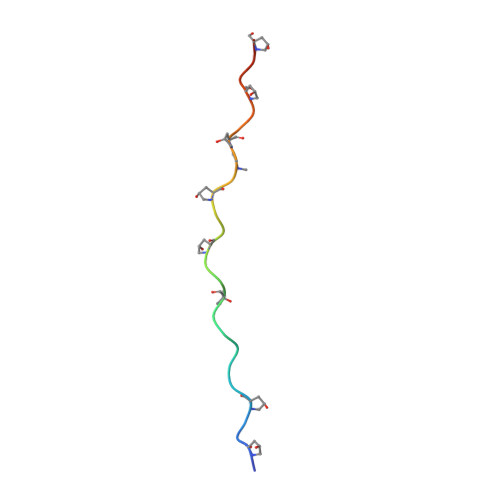Rules for the design of aza-glycine stabilized triple-helical collagen peptides.
Melton, S.D., Brackhahn, E.A.E., Orlin, S.J., Jin, P., Chenoweth, D.M.(2020) Chem Sci 11: 10638-10646
- PubMed: 34094319
- DOI: https://doi.org/10.1039/d0sc03003a
- Primary Citation of Related Structures:
6W46, 6W47 - PubMed Abstract:
The stability of the triple-helical structure of collagen is modulated by a delicate balance of effects including polypeptide backbone geometry, a buried hydrogen bond network, dispersive interfacial interactions, and subtle stereoelectronic effects. Although the different amino acid propensities for the Xaa and Yaa positions of collagen's repeating (Glycine-Xaa-Yaa) primary structure have been described, our understanding of the impact of incorporating aza-glycine (azGly) residues adjacent to varied Xaa and Yaa position residues has been limited to specific sequences. Here, we detail the impact of variation in the Xaa position adjacent to an azGly residue and compare these results to our study on the impact of the Yaa position. For the first time, we present a set of design rules for azGly-stabilized triple-helical collagen peptides, accounting for all canonical amino acids in the Xaa and Yaa positions adjacent to an azGly residue, and extend these rules using multiple azGly residues. To gain atomic level insight into these new rules we present two high-resolution crystal structures of collagen triple helices, with the first peptoid-containing collagen peptide structure. In conjunction with biophysical and computational data, we highlight the critical importance of preserving the triple helix geometry and protecting the hydrogen bonding network proximal to the azGly residue from solvent. Our results provide a set of design guidelines for azGly-stabilized triple-helical collagen peptides and fundamental insight into collagen structure and stability.
Organizational Affiliation:
Department of Chemistry, University of Pennsylvania 231 South 34th Street Philadelphia Pennsylvania 19104 USA dcheno@sas.upenn.edu.


















